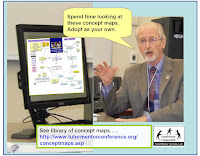11-6-2024 update - the election was not the result I and millions of others wanted. Yet, what I wrote last week is still true.
The US election next week will be a tipping point. Which way do we go as a democracy? I voted for Kamala Harris and hope she wins. But I realize that is just a step in the work we need to be doing to solve the complex problems facing the US and the world.
I've used this blog since 2008 to share uses of GIS maps to show where people need extra help, and to show where help is being delivered. In one set of links in the Tutor/Mentor library I point to many websites showing uses of GIS maps.
I've posted several articles over the past 20 years showing why I've built a library and how I hope people will use it.Below is a post I saw on Twitter, showing a "Social Change Ecosystem Framework" developed by Deepa Iyer, of the SolidarityIs and Building Movement Project.
Here's an article by Deepa Iyer that describes a use of this Social Change Map. I love the "hub and spoke" design she uses and how this shows the range of people and networks who need to be part of any problem-solving ecosystem..@aliciasanchez: This #SocialChangeMap ecosystem reduces hierarchy, but also shows how roles can be racialized & gendered: "Is it always women of color who are caregivers in your life? Is it always white folks who are considered visionaries? What's the power dynamic around that?" pic.twitter.com/cWLHqRfRdL
— Building Movement Project (@BldingMovement) November 16, 2022
I've used similar visualizations for more than 20 years.
I found another on my LinkedIn feed this week.
One of the features of this graphic is that it shows relationships and how the problems are inter-related to each other.
What would have made it better (in my opinion) would have been links from each node, to web libraries with information about each problem.
I hypothesize that every link I point to from my library represents an ecosystem of many people working for that organization and an even greater number who that organization and its employees connect with.

View Greg's Nov 15 presentation to ChiHackNight. click here
When we were planning the Tutor/Mentor Connection in 1993 and talking about building a directory our PR partner from Public Communications, Inc. in Chicago, said "You've got to host a conference!".
Since forming the Tutor/Mentor Institute, LLC in 2011 the range of people I've been reaching dramatically declined and conference participation dropped to around 100 per event.
1) the world is dealing with complex problems and some people are creating great visualizations showing this complexity;
The "information collection" described in this article is just STEP 1. Getting people to look at the information (step 2) and helping them understand it (step 3) and use it (step 4) also need to be funded and supported as part of any problem-solving process.
Electing Kamala Harris and Tim Walz blunts the regressive policies being promoted by the ultra conservatives but does not fix the problems that we face. Those who are funding Trump will still be trying to change the face of America in 2025 and beyond.
It will take an ecosystem of people to build and sustain an America that creates hope and opportunity for everyone and dims the passions of the fanatics. I hope the next administration helps such systems grow and that my resources will be useful.






